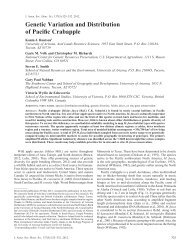CONSERVATION
Conservation You Can Taste - The Southwest Center - University of ...
Conservation You Can Taste - The Southwest Center - University of ...
- No tags were found...
You also want an ePaper? Increase the reach of your titles
YUMPU automatically turns print PDFs into web optimized ePapers that Google loves.
manager. “the biggest challenges early on were<br />
quality and supply. People would try buffalo and then<br />
say, ‘I’m glad I tried it but I’m never going to try it<br />
again.’ You just (let) that happen in a restaurant.”<br />
Unlike beef, there is no USDA grading system for<br />
buffalo. As the market expanded, accountability—<br />
and quality—has risen along with it. Many processors<br />
work directly with producers, offering feedback on<br />
the size of their animals and the cuts of meat. Dutton<br />
has found that small producers often get overwhelmed<br />
by how much meat the restaurant requires, so the<br />
Buckhorn Exchange now purchases most of their<br />
meat from two processors—Castlerock Meats and<br />
Prairie Harvest.<br />
“The perceived value of bison has increased, all<br />
the way from the chef at restaurant to the diner,” said<br />
Steve Hauff. “Because the customer is aware of the<br />
health qualities and flavor qualities, buffalo has gone<br />
up a rung or two in pricing in the last two years. People<br />
are not blinking an eye at the price of buffalo…,”<br />
Which is a boon for new producers. “There’s<br />
only one way to incentivize producers to raise more<br />
animals and that’s through economics,” said Bob<br />
Dineen of Rocky Mountain Natural Meats.<br />
Other barriers to entry for new producers<br />
include the high upfront cost of containment<br />
systems, as buffalo will tear through barbed wire<br />
fencing. “An upside is that bison thrive in really<br />
rugged weather conditions,” said Dineen. “They are<br />
lower management, lower input.” But because bison<br />
are wild animals that subsist mainly on foraging<br />
grasses—although some producers supplement with<br />
grain-based feed when wild forage is low—their<br />
survival and growth depend on the whims of weather.<br />
“Drought years affect us intensely,” said Hauff.<br />
“Buffalo are 99 percent prairie-raised and prairies<br />
(have in recent years been affected by) the most<br />
intense and fastest climate change than anywhere<br />
on earth.”<br />
This volatility in supply affects the price, which<br />
in turn affects the accessibility. The higher price<br />
of buffalo meat is a double-edged sword. Ground<br />
buffalo usually costs twice as much as ground beef.<br />
62



